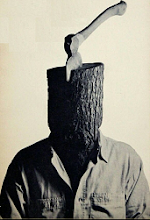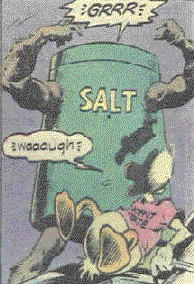Hittin' the Juke Joint
Comics are like rock music: bastardized forms of art, laden with potential, often bogged down by pretension, and, sadly, often derivative and stupid. And believe me, self-publishing is a lot like putting together your own band.*
I’ve been making good headway on writing my anthology comic, which may someday actually see production. Metaphorically speaking, right now I’m in my garage, screwing with the whammy bar on my Stratocaster, working on lyrics, and trying not to put out the four millionth retread of Led Zeppelin.
Between sessions, I’ve been breaking out the old stuff to get in the mood and pick up some inspiration. So yeah, I’ve been marinating in Kirby, Eisner, Moore, all sorts of folks. The pioneers and giants of rock. It’s been great.
But even the earliest and most primal of rock had its predecessor. Out of curiosity, I’ve been getting into the ancestor of the soopa-hero comic, the blues to comic’s rock: the pulps.**
Pulp novels are, by and large, friggin’ awful. Written under hideous deadlines with prose so inept and characters so broad it makes one’s eyes water, they are consummate trash. They’re simple, crude, and violent. They’re also bursting with action, adventure, and wild happenings.
Traditionally, the father of the comic book is said to be the comic strip, and yes, it’s true. Pulps are not comics’ father. They are comics’ bad-boy uncle, who gave the wee medium its first sips of beer, taught it swear words, and gave it fireworks to play with when mom wasn’t looking. Comic strips gave comic books their form and vocabulary; pulps gave comics their speed and heat.
The iconic adventure comic strips, such as Alex Raymond’s Flash Gordon and Milton Caniff’s Steve Canyon, look more than a little like modern comics, and many comic artists list them as influences. The pace and flavor of the classic adventure strips, however, is entirely different. Those stories would stretch for months, sometimes meandering, sometimes even dull.
Pulps didn’t slow down for anything. They came out monthly and had to tell complete stories. They tore across the page like the authors’ shoes were on fire. Killer robots, cackling madmen, clouds of vampire bats attacking cities, all could be found in the crappy prose of the pulps. Pulp novels were the place to find the insane velocity and sheer imagination that would fill superhero comics.
They were also the birthplace of much of the superhero idea. Compare the dull and staid heroes of comic strips (e.g., Flash Gordon, Buck Rogers, Steve Canyon—each one essentially “The Square-Jawed Hero”***) to the main heroes of the pulps:
The Shadow, a mysterious vigilante who was a master of disguise and hypnotism. His true name and origins a mystery for years, he travelled the world disguised as the millionaire Lamont Cranston (the real Cranston was hiding in East Asia) and meted out justice to villains large and small.****
Doc Savage, the original übermench. Doctor Clark W. Savage, Jr., was a six-foot-six bronzed muscleman and all-around genius, trained from birth by his crusading father to be the ultimate weapon in the war against eeeevil. Doc was joined by five assistants, each one an expert in a particular field. Time and again, Doc fought would-be world conquerors and super-science menaces.
And how about The Spider? Dick Wentworth was a vigilante who stalked the night disguised in a black suit, accessorized with a black mask, a hunchback, and fangs. Yes, a hunchback and fangs. The Spider was a sadomasochistic psychopath dedicated to his vision of justice, and rare was the story where only a handful of people died. His stories were the most overheated in the pulp oeuvre, and had delirious titles like “Death Reign of the Vampire King” and “The Pain Emperor.”
The descendents of Flash Gordon are hard to spot in comics. The sons of Doc Savage and the Shadow are everywhere. The most famous pulp hero of all time is still selling comics in big numbers.
The hero pulps aren’t good. Oh, lord no. But as a would-be comic writer, I’m fascinated by them and recommend them to my fellow comiccenti. Tasty morsels of weirdness and fun can be found hiding in the thickets of their purple prose.
Plus, the history they present is fun by itself. Reading the hero pulps as a comic fan is like opening a family album and realizing that your great-uncle Bjorn had the same damn uni-brow you do.
Harvey Jerkwater says check ‘em out.
----------------------
*I’ve had many musician roomates and seen bands rise and fall. The parallels between comic publishing and small-time music are many and strong. Though comic guys tend not to get quite so many groupies. Alas.
**I’m restricting myself here to the “hero pulps,” the ones with recurring lead characters. There was well-written pulp fiction published, such as the detective magazine Black Mask, that gave the world Dashiell Hammett. I’m sticking to the hero crap for this essay.
***With Dick Tracy being the ultimate “Square-Jawed Hero.” Wotta chin. You could open letters with his face.
****Ten points to the first person who can give me the Shadow’s true name and background. (Not the radio version of the Shadow, but the pulp version.) Twenty points if you can get the name without using the internet to find it.
I’ve been making good headway on writing my anthology comic, which may someday actually see production. Metaphorically speaking, right now I’m in my garage, screwing with the whammy bar on my Stratocaster, working on lyrics, and trying not to put out the four millionth retread of Led Zeppelin.
Between sessions, I’ve been breaking out the old stuff to get in the mood and pick up some inspiration. So yeah, I’ve been marinating in Kirby, Eisner, Moore, all sorts of folks. The pioneers and giants of rock. It’s been great.
But even the earliest and most primal of rock had its predecessor. Out of curiosity, I’ve been getting into the ancestor of the soopa-hero comic, the blues to comic’s rock: the pulps.**
Pulp novels are, by and large, friggin’ awful. Written under hideous deadlines with prose so inept and characters so broad it makes one’s eyes water, they are consummate trash. They’re simple, crude, and violent. They’re also bursting with action, adventure, and wild happenings.
Traditionally, the father of the comic book is said to be the comic strip, and yes, it’s true. Pulps are not comics’ father. They are comics’ bad-boy uncle, who gave the wee medium its first sips of beer, taught it swear words, and gave it fireworks to play with when mom wasn’t looking. Comic strips gave comic books their form and vocabulary; pulps gave comics their speed and heat.
The iconic adventure comic strips, such as Alex Raymond’s Flash Gordon and Milton Caniff’s Steve Canyon, look more than a little like modern comics, and many comic artists list them as influences. The pace and flavor of the classic adventure strips, however, is entirely different. Those stories would stretch for months, sometimes meandering, sometimes even dull.
Pulps didn’t slow down for anything. They came out monthly and had to tell complete stories. They tore across the page like the authors’ shoes were on fire. Killer robots, cackling madmen, clouds of vampire bats attacking cities, all could be found in the crappy prose of the pulps. Pulp novels were the place to find the insane velocity and sheer imagination that would fill superhero comics.
They were also the birthplace of much of the superhero idea. Compare the dull and staid heroes of comic strips (e.g., Flash Gordon, Buck Rogers, Steve Canyon—each one essentially “The Square-Jawed Hero”***) to the main heroes of the pulps:
The Shadow, a mysterious vigilante who was a master of disguise and hypnotism. His true name and origins a mystery for years, he travelled the world disguised as the millionaire Lamont Cranston (the real Cranston was hiding in East Asia) and meted out justice to villains large and small.****
Doc Savage, the original übermench. Doctor Clark W. Savage, Jr., was a six-foot-six bronzed muscleman and all-around genius, trained from birth by his crusading father to be the ultimate weapon in the war against eeeevil. Doc was joined by five assistants, each one an expert in a particular field. Time and again, Doc fought would-be world conquerors and super-science menaces.
And how about The Spider? Dick Wentworth was a vigilante who stalked the night disguised in a black suit, accessorized with a black mask, a hunchback, and fangs. Yes, a hunchback and fangs. The Spider was a sadomasochistic psychopath dedicated to his vision of justice, and rare was the story where only a handful of people died. His stories were the most overheated in the pulp oeuvre, and had delirious titles like “Death Reign of the Vampire King” and “The Pain Emperor.”
The descendents of Flash Gordon are hard to spot in comics. The sons of Doc Savage and the Shadow are everywhere. The most famous pulp hero of all time is still selling comics in big numbers.
The hero pulps aren’t good. Oh, lord no. But as a would-be comic writer, I’m fascinated by them and recommend them to my fellow comiccenti. Tasty morsels of weirdness and fun can be found hiding in the thickets of their purple prose.
Plus, the history they present is fun by itself. Reading the hero pulps as a comic fan is like opening a family album and realizing that your great-uncle Bjorn had the same damn uni-brow you do.
Harvey Jerkwater says check ‘em out.
----------------------
*I’ve had many musician roomates and seen bands rise and fall. The parallels between comic publishing and small-time music are many and strong. Though comic guys tend not to get quite so many groupies. Alas.
**I’m restricting myself here to the “hero pulps,” the ones with recurring lead characters. There was well-written pulp fiction published, such as the detective magazine Black Mask, that gave the world Dashiell Hammett. I’m sticking to the hero crap for this essay.
***With Dick Tracy being the ultimate “Square-Jawed Hero.” Wotta chin. You could open letters with his face.
****Ten points to the first person who can give me the Shadow’s true name and background. (Not the radio version of the Shadow, but the pulp version.) Twenty points if you can get the name without using the internet to find it.





3 Comments:
How about Kent Allard, the pilot that Cranston hired? That's in my Howard Chaykin trade paperback, anyway ... (is that cheating?)
By Greg, at 8:47 PM
Greg, at 8:47 PM
Calling pulps the blues to comic's rock and roll? A fine phrase, my friend.
My dad was a huge Spider fan and was delighted when we found recent paperbacks of the old pulp adventures. And man, are they trashy!
Have you read Warren Ellis' take on the old pulp heroes in Planetary? He has a Spider/Shadow (who is the son of the Lone Ranger (!!)), a Doc Savage, a Tarzan--all of them, for the most part.
By gorjus, at 10:59 AM
gorjus, at 10:59 AM
Greg is right. In the pulps, the true identity of the Shadow was Kent Allard, a pilot and former spy.
Why Allard became the Shadow was never really explained. Probably, in the grand tradition of pulp heroes, he just figured somebody had to do it. Those world-conquering madmen and mongol warlords don't defeat themselves, you know.
For an interesting but overlong history of the Shadow, check out this PDF file. It's a bit terrifying in its obsessiveness, but it gives the dirt.
By Harvey Jerkwater, at 1:21 PM
Harvey Jerkwater, at 1:21 PM
Post a Comment
<< Home